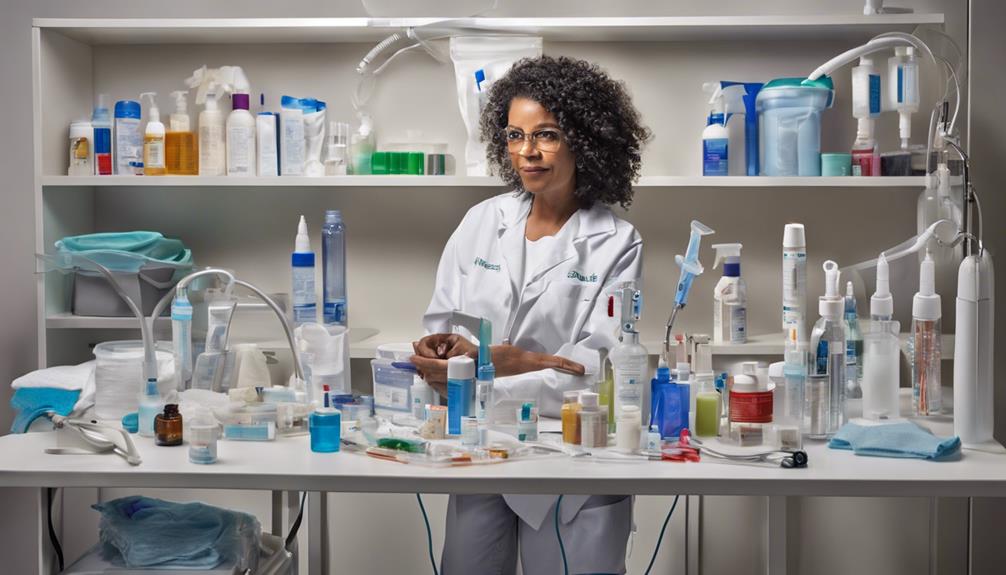In long-distance caregiving, we must use effective communication strategies like setting specific times for calls and video chats. Building a strong care team involves assigning roles and providing regular updates. Utilize technology for remote support by using monitoring devices and scheduling telehealth options. Seek community resources for help and explore respite care services for relief. Guarantee quality care professionals by thoroughly evaluating their qualifications. Prioritize self-care by setting boundaries and seeking support. Create a support system early on for reduced stress levels. Stay connected through regular communication and virtual visits. Taking care of both caregiver and recipient is essential for success. Mastering these tips is vital!
Key Takeaways
- Establish regular communication schedules with family and local caregivers.
- Utilize technology like teleconferences for virtual check-ins.
- Build a strong care team with clear roles and responsibilities.
- Utilize remote monitoring devices for real-time health updates.
- Seek community resources for additional support and assistance.
Effective Communication Strategies
To guarantee smooth coordination and updates on our loved one's well-being, establishing regular communication schedules is vital when caregiving from a distance. As caregivers, our communication responsibilities play an essential role in ensuring the best care for our loved ones. By setting up specific times for calls, video chats, or even just quick check-in messages, we can stay informed about any changes in their health or needs.
Utilizing technology like teleconferences can also aid in discussing care plans effectively with family members and local caregivers. These communication schedules not only help us stay organized but also foster a sense of teamwork and support among everyone involved in the caregiving process.
Building a Strong Care Team

When constructing a robust care team, it's essential to establish clear team communication strategies to make sure everyone is on the same page.
Assigning specific roles and responsibilities to each member helps streamline tasks and avoid confusion.
Team Communication Strategies
Building a strong care team involves establishing clear roles for each member and effectively delegating tasks as needed. Communication is key in making certain everyone is on the same page. Utilizing technology can aid in staying connected and informed. Below is a table outlining some team communication strategies:
| Strategy | Description | Benefit |
|---|---|---|
| Regular Updates | Provide frequent progress reports to keep everyone informed. | Guarantees transparency and accountability. |
| Virtual Check-Ins | Schedule video calls to discuss important matters and check on your loved one. | Facilitates face-to-face communication regardless of distance. |
| Communication Apps | Use apps for instant messaging and updates on the go. | Allows quick and efficient sharing of information. |
Roles and Responsibilities
Establishing specific roles and responsibilities for each team member is vital in building a strong care team. When each member knows their tasks, caregiving becomes more efficient and supportive. By assigning roles, the workload is shared, ensuring all aspects of care are addressed.
Communication within the care team is essential for coordination and effective caregiving. Clear communication helps everyone understand their responsibilities and fosters teamwork. A well-organized care team can offer better support and enhance the overall caregiving experience.
Assigning roles and responsibilities within the care team creates a structured approach to caregiving, leading to improved outcomes. Effective communication and clear delineation of responsibilities are key to a successful care team.
Utilizing Technology for Remote Support
Utilizing technology plays a crucial role in enabling long-distance caregivers like us to stay connected and monitor the well-being of our loved ones remotely. Here are three ways technology can enhance remote support for caregiving:
- Remote Monitoring Devices: These devices provide real-time updates on the health and activities of our loved ones. From tracking vitals to movement patterns, these tools offer valuable insights into the care recipient's well-being.
- Communication Apps: Utilizing communication apps allows for instant contact and updates. Video calls offer face-to-face interaction, providing visual reassurance and strengthening the emotional bond despite the physical distance.
- Telehealth Options: Caregivers can schedule medical consultations for their loved ones through telehealth services, eliminating the need to be physically present. This technology guarantees that our care recipients receive timely medical attention and care, even from afar.
Seeking Community Resources

To further support our caregiving journey from a distance, we can tap into various community resources that offer assistance and guidance. Contacting local aging agencies, such as Area Agencies on Aging, can provide valuable information on available community resources and support programs tailored to the needs of caregivers and their loved ones.
Attending caregiver support groups or workshops is another beneficial way to connect with individuals facing similar challenges and gain insights into effective caregiving strategies. Additionally, exploring respite care services can offer temporary relief for caregivers, allowing them to take much-needed breaks and recharge.
Inquiring about meal delivery services and transportation assistance can help meet the practical needs of the care recipient, ensuring their well-being. Visiting senior centers can also be advantageous, as they often provide social engagement opportunities like classes, activities, and events specifically designed for older adults. Additionally, exploring local community resources can uncover valuable information about the top home care services for seniors that offer personalized care tailored to individual needs. Engaging with healthcare professionals can also provide insights into additional supportive services that enhance quality of life. By proactively seeking these resources, caregivers can create a well-rounded support system that promotes both physical health and emotional well-being for their loved ones.
Ensuring Quality Care Professionals

When seeking high-quality care professionals, it's vital to thoroughly evaluate their qualifications. Conducting interviews with caregiver candidates enables us to assess their skills and suitability for our loved one's requirements.
Verifying that the caregivers' credentials and experience align with our expectations is paramount for delivering exceptional care from a distance.
Screening Caregiver Qualifications
We prioritize verifying the credentials and experience of care managers to guarantee they meet the necessary qualifications for providing quality care. When screening caregiver qualifications, consider the following:
- Evaluate Credentials: Check for relevant certifications and licenses held by the care manager, ensuring they've the necessary training to care for your loved one.
- Assess Experience: Inquire about the care manager's previous work experience and specialties to determine their expertise in handling your loved one's specific needs.
- Seek Recommendations: Ask for references or reviews from past clients to gain insight into the care manager's reputation and the quality of care they provide.
Interviewing Caregiver Candidates
After screening caregiver qualifications, the next step is to engage in thorough interviews with potential candidates to guarantee we secure quality care professionals for our loved ones.
When interviewing caregiver candidates, it's essential to verify their credentials and experience to make sure they can provide the level of care needed. Discuss their availability and expertise to assess if they align with the specific care requirements.
Remember that Medicare and most health insurance plans typically don't cover care management services, so consider the costs associated with hiring a reputable caregiving professional.
Make your hiring decision carefully, ensuring that the selected care manager not only meets but also exceeds the specific needs and preferences of your loved one.
Prioritizing Self-Care

Prioritizing self-care as long-distance caregivers involves consciously dedicating time and effort towards maintaining personal well-being to prevent burnout and guarantee effective caregiving.
To make sure you're caring for yourself while supporting your loved one, consider the following key practices:
- Taking Breaks: Schedule regular breaks to rest and recharge, allowing yourself time to relax and rejuvenate.
- Setting Boundaries: Establish clear boundaries between your caregiving responsibilities and personal life to prevent feelings of overwhelm and exhaustion.
- Seeking Support: Reach out to friends, family, or support groups for emotional assistance and guidance, recognizing that it's okay to ask for help.
Engaging in these self-care strategies can't only enhance your own well-being but also positively impact the quality of care you provide to your loved one.
Creating a Support System

To guarantee effective caregiving and maintain personal well-being, establishing a strong support system is essential for long-distance caregivers. Research has shown that caregivers who've a support network in place experience reduced stress levels and achieve better outcomes for their loved ones.
Engaging with support groups and community resources can greatly improve the mental well-being of long-distance caregivers, equipping them with the tools to handle the challenges they may face. By delegating tasks to their support system, caregivers can combat feelings of isolation and burnout, ultimately enhancing the quality of care provided to their loved ones.
It's vital to establish a support system early on in the caregiving journey to effectively manage responsibilities and prevent caregiver strain. Having a support system not only helps caregivers feel more connected and informed about their loved one's well-being but also enables them to navigate the complexities of long-distance caregiving with greater ease.
Staying Connected

Regular communication with the care recipient and local caregivers is essential for maintaining strong connections when caregiving from afar.
By utilizing technology like video calls and messaging apps, we can bridge the physical distance and stay updated on our loved one's well-being.
Setting up regular virtual visits not only provides emotional support but also helps us feel present in their daily lives.
Regular Video Calls
Implementing frequent video calls is essential for long-distance caregivers to maintain a strong connection with their loved ones and actively monitor their well-being. Video calls offer a unique opportunity to visually assess the care recipient's condition and provide support from a distance.
Here are some benefits of regular video calls for long-distance caregivers:
- Visual Observation: Allows for monitoring changes in appearance, behavior, and living conditions.
- Remote Participation: Enables involvement in medical appointments, care planning, and issue resolution.
- Emotional Support: Provides a personal and interactive way to offer companionship, reassurance, and emotional connection.
Regular video calls can bridge the physical distance between caregivers and their loved ones, fostering a sense of closeness and ensuring effective caregiving.
Utilize Online Resources
How can long-distance caregivers effectively stay connected and access valuable support resources for their caregiving responsibilities? Caregiving websites offer a wealth of information on health conditions, care options, legal matters, and financial planning, aiding in informed decision-making.
Telehealth services allow caregivers to remotely consult healthcare providers, ensuring their loved ones receive necessary medical attention.
Social media platforms provide a sense of community, connecting caregivers with others facing similar challenges and fostering a supportive environment.
Utilizing online communication tools like video calls, messaging apps, and email enables caregivers to maintain close contact with their loved ones and care team, bridging the distance and ensuring efficient coordination of care.
Taking Care of Caregiver and Recipient

To guarantee the well-being of both the caregiver and the care recipient, prioritizing self-care and maintaining open communication is essential for long-distance caregiving. Here are some key ways to take care of both the caregiver and the recipient:
- Family Support: Involving other family members in the caregiving process can provide much-needed assistance and emotional support. Sharing responsibilities among family members can lighten the load on the primary caregiver and make sure the recipient receives thorough care.
- Self-Care Practices: Carving out time for self-care activities, such as exercise, relaxation techniques, and hobbies, is critical for the caregiver's physical and mental well-being. Taking care of oneself enables the caregiver to continue providing quality care to the recipient without experiencing burnout.
- Open Communication: Regular and honest communication with the care recipient is essential for maintaining a strong and trusting relationship. Discussing any concerns, needs, or changes in care openly can help address issues promptly and safeguard the well-being of both parties.
Essential Aspects of Successful Caregiving

Coordinating care effectively begins with creating a detailed care plan in advance. A care plan outlines the specific needs of the care recipient, schedules for medication, doctor's appointments, and other essential tasks. It serves as a roadmap for caregivers to follow, guaranteeing nothing is overlooked.
Recognizing red flags that indicate the need for in-home care is essential. Changes in the care recipient's behavior, unexplained bruises, or sudden weight loss could signal the necessity for additional assistance.
Discussing caregiving responsibilities with family members allows for effective delegation of tasks and the sharing of the caregiving burden.
In Distance Caregiving, having a support network in place is critical. Regular check-ins with the care recipient and healthcare providers help monitor well-being from afar.
Understanding the signs of elder abuse and taking preventive measures is also necessary. By staying informed and proactive, caregivers can safeguard the safety and well-being of their loved ones.
Frequently Asked Questions
How Can I Be a Good Caregiver to a Little Long Distance?
We stay connected through regular communication, utilizing technology for strong bonds. Coordinating with local caregivers and providers guarantees thorough care. Strategically planning visits maximizes quality time. Prioritizing self-care prevents burnout, allowing effective support from afar.
How Can I Help a Long Distance Caregiver?
We provide support through regular communication, help with research on local resources, coordinate visits, stay updated on health information, aid in creating care plans, organize documents, and establish emergency protocols. Let's collaborate to guarantee efficient caregiving from a distance.
What Is Your Strongest Skill as a Caregiver?
Our strongest skill as caregivers is effective communication. We listen attentively, convey empathy, and guarantee clarity in our interactions. This skill allows us to connect deeply with those we care for, fostering trust and understanding in our relationships.
How Do I Become a Successful Caregiver?
We become successful caregivers by prioritizing communication, self-care, technology, community resources, and quality care. Staying informed, preventing burnout, and utilizing support services help us provide effective care and safeguard the well-being of our loved ones.
Conclusion
To sum up, looking after a loved one from a distance can be challenging, but with the right strategies in place, it's possible to provide quality care and support.
By utilizing communication tools, building a strong care team, and staying connected, long distance caregiving can be made easier and more effective.
Remember to prioritize self-care, seek community resources, and guarantee the well-being of both the caregiver and recipient.
With these tips in mind, you can successfully navigate the complexities of long distance caregiving.









